April 7, 2023
Air Date: April 7, 2023
FULL SHOW
SEGMENTS
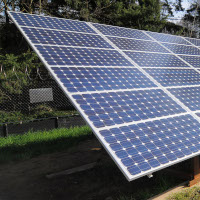
Green Energy Gridlock
View the page for this story
America can’t meet its goals of reducing carbon pollution from power plants unless power grids get major upgrades and rules to bring clean energy online are detangled. American Clean Power Association CEO Jason Grumet joins Host Jenni Doering to explain the challenges and opportunities facing implementation of the Inflation Reduction Act. (12:02)
Koala: A Natural History and Uncertain Future
View the page for this story
The koala is an iconic character in Australian wildlife but remains an enigma to many. Danielle Clode, an award-winning Australian author, set out to discover the fascinating story behind the koala’s cuddly image for her new book, Koala: A Natural History and an Uncertain Future. She joined Hosts Steve Curwood and Jenni Doering for a recent Living on Earth Book Club event. (17:59)
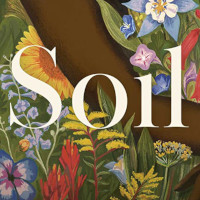
The Next Event in the Living on Earth Book Club
In "Soil: The Story of a Black Mother's Garden," poet and scholar Camille T. Dungy recounts the seven-year odyssey to diversify her garden in the predominately white community of Fort Collins, Colorado. The Living on Earth Book Club, Soul Fire Farm, Orion Magazine and UMass Boston School for the Environment proudly present this free, live, virtual conversation between author Camille Dungy and Host Steve Curwood, with a special introduction by Soul Fire Farm co-founder Leah Penniman. ()
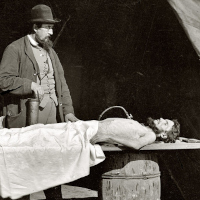
Beyond the Headlines
/ Peter DykstraView the page for this story
Living on Earth contributor Peter Dykstra joins Host Jenni Doering to share news of the uptick in green burials and a new study that finds a link between climate change and the powerful supercell storms that can give rise to destructive tornadoes. And in the history calendar, they look back 75 years to the indictment of nine corporations for allegedly conspiring to shut down streetcar lines in Los Angeles and elsewhere and replace them with buses made or fueled with their own products. (04:43)
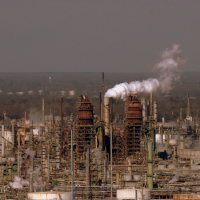
Righting the Wrongs of Environmental Racism
View the page for this story
The Black residents of the heavily industrialized corridor along the Mississippi known as “Cancer Alley” have filed a civil rights and religious liberty lawsuit against the parish council that has given a green light to these polluting facilities for decades. Monique Harden of the Deep South Center for Environmental Justice joins Host Steve Curwood to explain the history of environmental racism and resistance in “Cancer Alley.” (12:18)
Show Credits and Funders
Show Transcript
230407 Transcript
HOSTS: Steve Curwood, Jenni Doering
GUESTS: Danielle Clode, Jason Grumet, Monique Harden
REPORTERS: Peter Dykstra
[THEME]
CURWOOD: From PRX – this is Living On Earth.
[THEME]
CURWOOD: I’m Steve Curwood.
DOERING: And I’m Jenni Doering.
Wind and solar projects are eligible for huge sums of federal money but they’re bogged down in red tape.
GRUMET: We have 5 years to just get permission to build a project and then another 5 years to get permission to connect it to the grid. This is fundamentally a question of, do we want these laws to work? Do we actually care about doing something about climate change? Or do we just want to talk about caring about doing something about climate change?
CURWOOD: Also, to help their babies eat eucalyptus, koala moms make a special microbial “soup”.
CLODE: Which is a pretty messy, disgusting looking thing, it has to be said, it’s quite horrifying, really. But the baby koalas just love it, they can’t get enough of it. And that gives them the microbes they need to digest the eucalypts.
CURWOOD: That and more this week on Living on Earth – Stick Around!
[NEWSBREAK MUSIC: Boards Of Canada “Zoetrope” from “In A Beautiful Place Out In The Country” (Warp Records 2000)]
[THEME]
Green Energy Gridlock
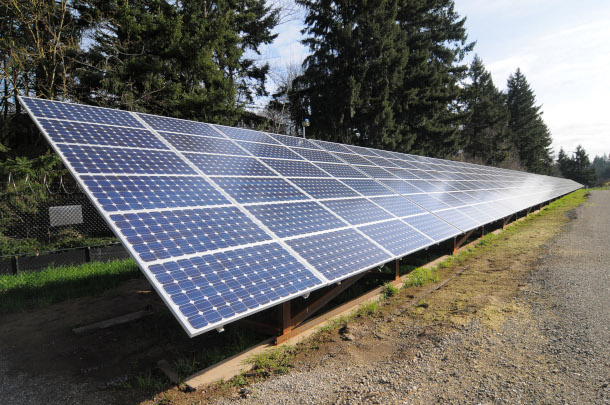
Among the states that have taken a variety of actions to encourage solar energy is Oregon. A 2017 state law bars homeowners’ associations from banning solar panels. (Photo by Portland General Electric, Flickr, CC BY-ND 2.0)
CURWOOD: From PRX and the Jennifer and Ted Stanley Studios at the University of Massachusetts Boston, this is Living on Earth. I’m Steve Curwood.
DOERING: And I’m Jenni Doering.
To stand a chance of meeting President Biden’s goal of 100 percent carbon pollution-free electricity by 2035, the United States is going to have to level up the power grid from fossil fuel based energy sources to take advantage of clean, renewable power. And there are hundreds of billions of federal dollars to support those clean energy projects, thanks to the Inflation Reduction Act. But plugging in that power is proving difficult. In addition to the usual land use permits and approvals required for new projects, solar and wind farms also have to get permission from local grid operators, who are working through a huge backlog of competing projects to consider. And the system of power grids in the U.S. right now is kind of like an old house where running the microwave and the toaster at the same time is probably going to trip a circuit breaker. There just isn’t enough capacity to carry all that current. Jason Grumet has spent decades working on bipartisan energy policy and he’s now CEO of the American Clean Power Association. Jason, welcome to Living on Earth!
GRUMET: It's great to be here.
DOERING: So, why is there such a backlog of energy projects? And what is it about renewable energy in particular, that can sometimes complicate the process of actually getting a project hooked up to the grid?
GRUMET: So, you know, the challenges facing renewable energy aren't that different from, you know, all types of energy projects. The issue is the speed with which we have to transform this incredibly giant economy. So there's been a process in place for years and years when it comes to citing a new energy facility, whether it was a pipeline or natural gas facility. And the process was basically designed to kind of protect communities from harm, right? It was, how do we make sure that while we need this energy, no aspect of this new production is going to undermine a community. And that's the process that we still have in place, right, the basic processes designed to kind of slow things down, because you don't want anything bad to happen. And now we're trying to flip the script right now, the question is, how do we speed up good things, but we're still stuck in a process that is really designed towards delay and has so many spots across the line for people to object that it's taking five years to just get the permission to build a project. Or if you want to build a transmission line, which is a critical aspect of what we're going to need to achieve compliance with a low carbon future that can take on average seven or eight years.
DOERING: So can you talk to me about this problem of interconnection. You know, the project itself may have the land, they may have all the materials, they need to build a wind farm or a solar farm but it's this problem of connecting it to the grid. What is happening there?
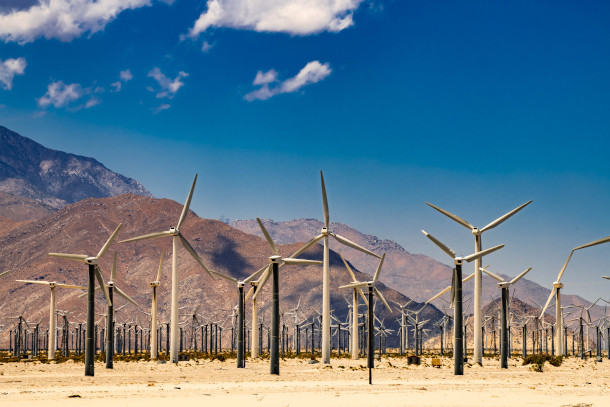
The San Gorgonio Pass wind farm stretches from the eastern slope of the San Gorgonio Pass to the western end of the Coachella Valley in California. The farm has a capacity of 652 MW and a single power line connects it to the Los Angeles Metropolitan area. (Photo: Daxis, Flickr, CC BY ND 2.0)
GRUMET: Right. So you know look we don't have a transmission system that was designed for clean power, or was designed to increase the transition to electric cars and other things that have the potential to be non polluting, right. The current electric power system was basically, you know, the hubs of the power production were in urban areas and the question was, how do you bring the lines out to rural America. We got to flip the whole process, right, the places where we're going to produce these vast amounts of clean power are mostly rural America. Its massive solar farms in Arizona, New Mexico, that need to ship power to California, it's significant wind farms in the plains in the Midwest that need to ship power to Chicago. The lines don't exist and so we have now significant investments that are necessary. But the process of actually getting a line approved, is incredibly arduous. It's hard, because you know, this they call this linear infrastructure, right. It's a very thin thing but it's got to go through 7 different states and 36 different counties, and every place along the way, gets a nibble at the process. And so the process is just so slow that we now have a backlog. And so in the Northeast, you have to wait five years to even get permission to connect to the grid. So you have five years to get permission to build a project, and then another five years to get permission to connect it to the grid, okay so that's 10 years. these great incentives in the inflation Reduction Act, they're 10 year incentives. So if we don't fix this, right, like, you know, that we're bringing a lot of carrots to the table and the carrots are gonna ride on the table. This is fundamentally a question of, do we want these laws to work? Do we actually care about doing something about climate change? Or do we just want to talk about caring about doing something about climate change?
DOERING: So what can Congress do to break through this gridlock? And also, what kind of bipartisan appetite is there in Congress right now for streamlining renewable energy projects?
GRUMET: So this is the nifty thing right, there was legislation that was introduced in the Senate last year supported by the Biden administration to streamline permitting, that had support from the majority of the Democratic senators, and not quite enough support from the Republicans. Legislation was just passed through the house run by Republicans, which has basically a lot of the same provisions and now the expectation is you're gonna have support from all the Republicans, and can you get 10 or 12 Democrats. When you're willing to recognize that this is about modernizing our energy economy, the dramatic amount of it's going to be renewable power, but we have to invest in cleaning up natural gas, we have to make sure that we actually have the capacity to keep the lights on because if they flicker, the whole system gets set back. If we're willing to acknowledge that we need a modernized permitting system for all aspects of new energy, then you can get a bipartisan coalition and you can get the 60 votes. If you're trying to do a bill that says we want to speed up oil and gas you're gonna lose. If we try to do a bill that says all we're trying to do is speed up wind and solar, you're gonna lose, and the truth is that we actually need it all. The economics are going to drive us towards clean power, we have to have the confidence that that is the case. So that when we allow things to get built, we allow everything to get built faster and know that you know, the outcome is going to be good for climate change.
DOERING: Right, and I think you're referring to the Lower Energy Costs Act that recently passed through the Republican led house. What are the ways that that Act departs from what you see as sort of an ideal piece of legislation that could deal with this gridlock?
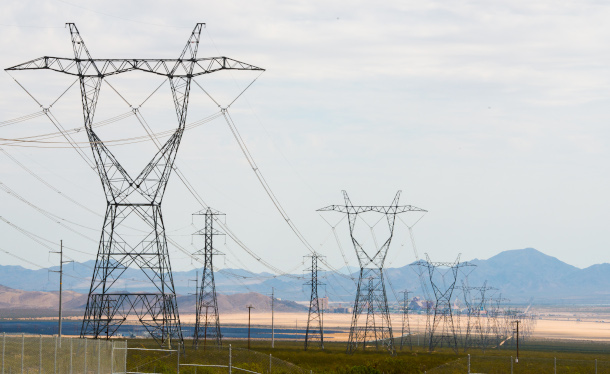
Transmission lines at the Ivanpah Solar Project, owned by NRG Energy, Bright Source Energy, Bechtel and Google. Building new transmission lines is one of the biggest challenges in implementing the renewable energy project goals outlined in the Inflation Reduction Act. (Photo: Dennis Schroeder, NREL, Flickr, CC BY-NC-ND 2.0)
GRUMET: So this recent bill passed the House is titled HR-1. And that means it's the very first piece of legislation that the House is moving forward. No piece of legislation titled HR-1 is ever designed to become law. This is the we won, you lost first piece of legislation. The Democrats did it two years ago with a voting rights and ethics bill that no one thought could become law, because it was loaded up with all kinds of things that were messaging bills, not substance bills. Now we've seen the kind of counterpart, this is a bill that is trying to do a whole lot of things across the energy sector. A lot of it has absolutely no chance of moving forward in a bipartisan Senate, everybody knows that. And so if you just basically focus on where the real action is, it's on permit reform. You know, because there are parts of the bill that are trying to undo aspects of the inflation Reduction Act and this might be what some part of the Republican Party wants but that's not going to become, you know, the outcome that the President, of course, would sign. So if you look at the permit issues, they're not that far apart from what the White House proposed a year and a half ago, there's this idea called one federal decision, which means you have one agency that actually has to be responsible, as opposed to everybody just kind of kicking the ball back and forth to each other. There is an idea that you have some time limits and page limits on how long these documents have to be. There's the notion that you should have kind of parallel processing wherever possible at the state and federal level. There's an idea that says, hey, if we've permitted, like three or four of these things already, we don't have to go back to a whiteboard and start all over again. But we can they call it kind of categorical exemptions, like once we figured out like hey, this is how you can permit a wind farm- can we just go back to that as the starting point? And so they sound like pretty biennial inside, you know, kind of process issues. And they are, right, no one is suggesting that we do away with core environmental statutes. But we are basically saying, if we don't put some kind of actual constraints on the system, we're never going to get to the clean energy revolution. So we're going to have fights about, are there any limits on how long people can bring lawsuits, there are going to be arguments about is there any need to put some restraints on what states can do, because after you go through the whole federal program then you can spend another 5 or 10 years with states asking additional questions. But that's what this is about, right? That is basically just good government. And if we do good government, we think we can triple the pace of renewable deployment from the best year ever, in five years. And if we don't bring some efficiency to the process, we won't, and we will fundamentally blow past 2050 with a high carbon economy.
DOERING: So there's the permitting issues. There's also the just physics of how electricity moves through transmission lines. And I understand that there's this problem here, where if I'm a wind energy company, and I see an opportunity to build a new wind farm somewhere, maybe I get all the permitting lined up. But then I realize, I'm told by the grid operator, that it's going to cost tens of millions of dollars extra just to link that project into the existing grid. Maybe that's going to cut into my profits in a way that I don't really think that project is feasible, or is worth it anymore for me. How do we fix that problem? Who should be paying for these upgrades to the grid and what are some solutions there?
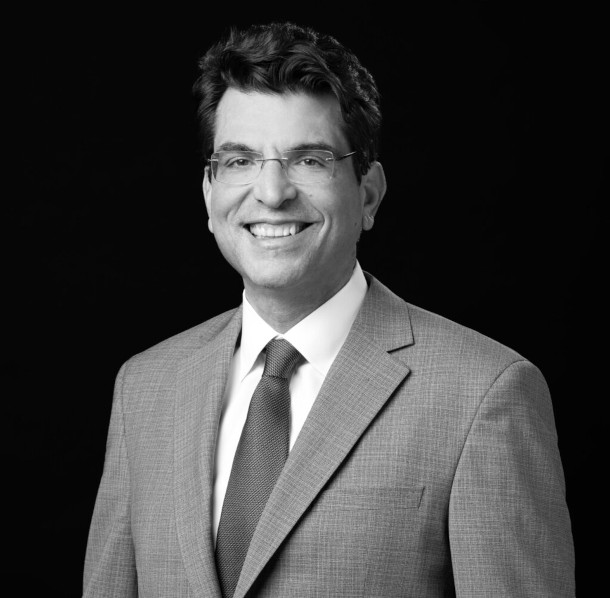
Jason Grumet is the Chief Executive Officer of the American Clean Power Association (ACP), a trade association representing the energy industry. (Photo: Courtesy of American Clean Power Association)
GRUMET: So the who pays for it is usually at the bottom of every big political fight and in this case, the fancy words are here, cost allocation, right. If you're building a new power line, and let's say you're building a power line from Nevada, massive solar installation to Los Angeles, the folks in Los Angeles want the power, but they'd like it to be really cheap so they'd like the folks in Nevada to pay for the power line. People in Nevada, like, hey, we're sending you power but it's also strengthening the resilience of your grid, it's providing public benefits for air quality, we'd like the recipients to pay for a piece of that action. And that's a place where there are two kinds of government actors who can do something about it. The first is Congress and so in the legislation that was Senator Manchin’s, leadership in the Senate last year, there was provisions around cost allocation that tried to say, here's how we're going to kind of share the costs of the transmission line in some kind of calibration to where we think the benefits are. That didn't get across the line, but it certainly opened the conversation and now I think when the legislation moves from the House to the Senate, that topic is going to come back. The House Bill did not focus that much on transmission, if there's going to be legislation passed in the Senate it will. The other actor is the Federal Energy Regulatory Commission, which is basically almost kind of like it sounds right, a group of very sophisticated engineers and economists to create the regulatory architecture for transmission. They also have some authority to kind of tell people who's got to pay for what, they have a couple of rules pending right now. And so, again, like this is where governments got to step up, you know, we have to find a way to make sure that the people who are receiving the benefits are actually covering the costs or the projects won't happen and we're seeing it everywhere. And one of the biggest challenges are with the offshore wind facilities, which have the potential to be just breakthroughs. I mean, these are massive facilities that could fundamentally transform the way we understand electric power, getting the power from offshore to the cities, we haven't figured that out yet. So that's another place where we need Congress or the executive branch to set out some rules.
DOERING: Jason Grumet is the CEO of American Clean Power Association. Thank you so much, Jason.
GRUMET: Really appreciate your digging in on this
DOERING: Just ahead – we catch up on our recent Living on Earth Book Club event and learn how the beloved koala lives off toxic eucalyptus leaves. Keep listening to Living on Earth.
Related links:
- New York Times | “The U.S. Has Billions for Wind and Solar Projects. Good Luck Plugging Them In”
- Reuters | “Exclusive: U.S. Solar Panel Imports from China Grow, Alleviating Gridlock, Officials Say”
- CNBC | “Why It’s So Hard to Build New Electrical Transmission Lines In The U.S.”
- Read the American Clean Power 2022 Market Report
- Inside Climate News | “Illinois Put a Stop to Local Governments’ Ability to Kill Solar and Wind Projects. Will Other Midwestern States Follow?”
[MUSIC: Julian Lage “Etude” on Squint, UMG Recordings, Inc.]
ANNOUNCER: Support for Living on Earth comes from Sailors for the Sea and Oceana. Helping boaters race clean, sail green and protect the seas they love. More information @sailorsforthesea.org.
[CUTAWAY MUSIC: Julian Lage “Etude” on Squint, UMG Recordings, Inc.]
Koala: A Natural History and Uncertain Future
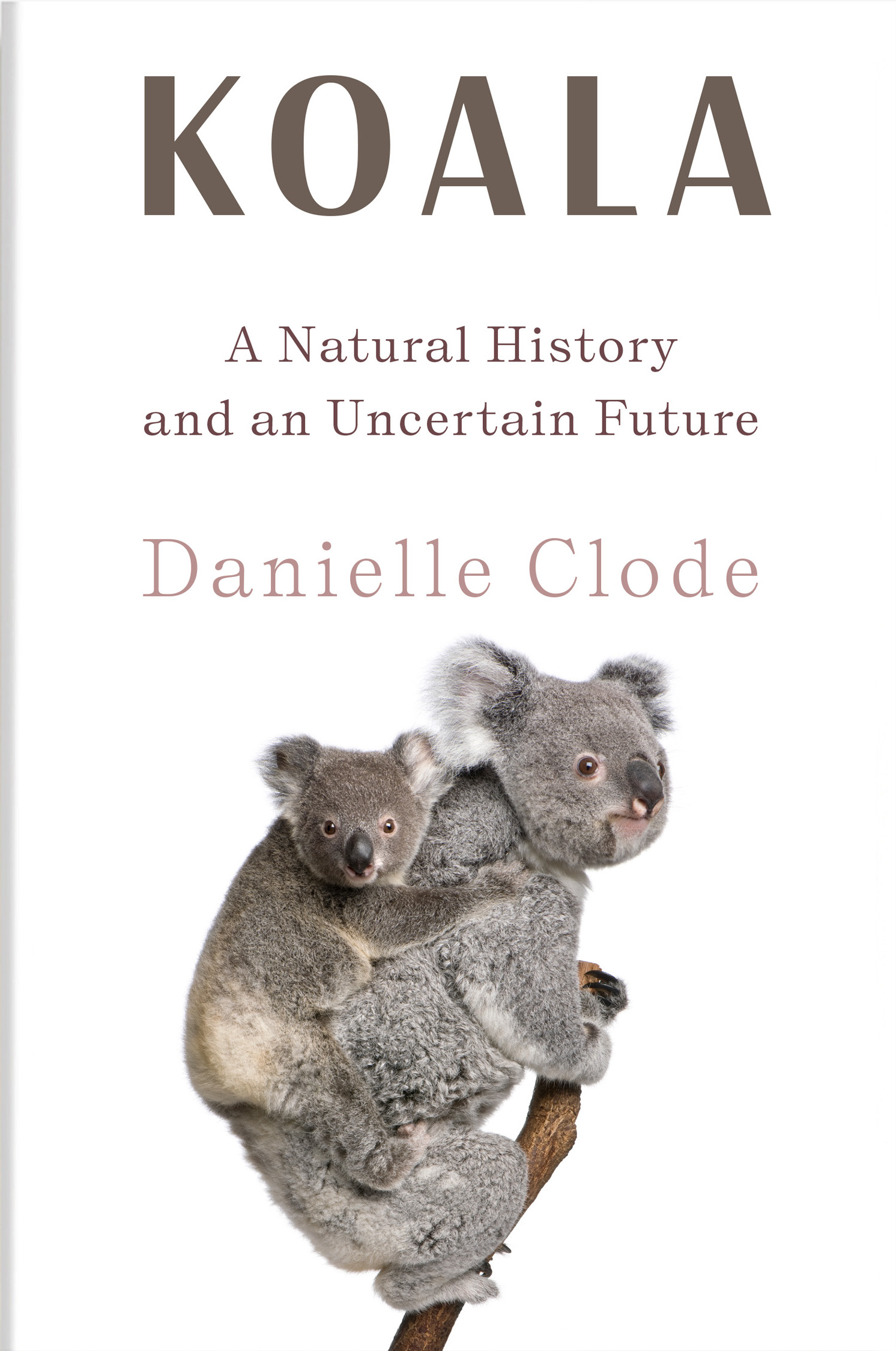
Danielle Clode’s new book, Koala: A Natural History and an Uncertain Future, dives into the world of this iconic creature. (Photo: W.W. Norton & Company)
DOERING: It’s Living on Earth, I’m Jenni Doering.
CURWOOD: And I’m Steve Curwood.
With fuzzy ears and an oblong nose, the koala is an iconic character in Australian wildlife. But beloved as the koala may be, it remains an enigma to many.
DOERING: Danielle Clode is an award-winning Australian author. And she set out to discover the fascinating story behind the koala’s cuddly image for her new book, Koala: A Natural History and an Uncertain Future. She joined us for a recent Living on Earth Book Club event. Danielle, welcome to Living on Earth!
CLODE: Thank you for having me. It's really wonderful to be here.
DOERING: So I have to ask, koalas of course have such a cuddly image. They're the most adorable creatures, but it's not really true that they're cuddly. Is that right?
CLODE: Yeah, look, it's a tricky one, isn't it? Because koalas can be cuddly, you know, it depends on the personality of the animal. But they are a wild animal. And they can be quite belligerent at times, and definitely prefer to be left on their own. So as far as wild animals go, they're fairly amiable in nature. But nonetheless, they've got some big claws and sharp teeth, so you do have to be careful with them.
CURWOOD: But Danielle, what is it about this adorable face? Why do we respond so strongly to them?
CLODE: I think that there's a lot of things about koalas that really appeal very directly to us. It says more about us than it does about koalas, you know? They have those forward facing features, like a human face, with the eyes and nose. So we as primates are particularly primed, we have special nerve cells that pick up on facial features. And so we're very, very primed to see faces, and koalas really trigger that in us, I think. They have a way of moving and a way of hanging on to things that reminds us of small children. So you know, they are toddler-sized, they appear to cling to you like a toddler does. They make crying noises that trigger a very maternal response. And very often, they will actually lift their arms up when they're seeking assistance. So they really tap into those sort of parental responses we have. And they're fluffy and cute, as well. That doesn't hurt either.
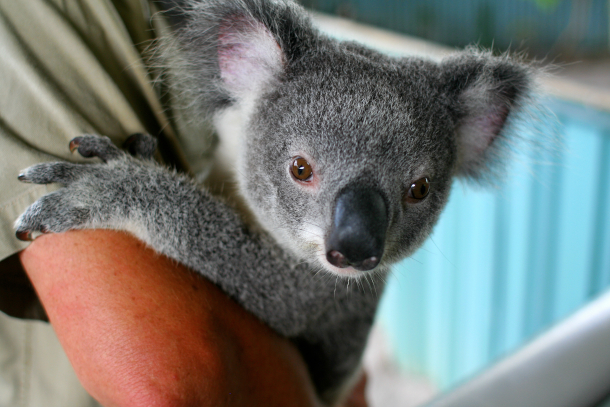
Born the size of a jellybean, a baby koala—or “joey”— must climb into its mother’s marsupial pouch to develop further. (Photo: Taz, Flickr, CC BY 2.0)
CURWOOD: You just have to wonder what happens in evolution. So let's turn to their diet, which is another thing that's just as intriguing, in some respects, as the desire they create within us to anthropomorphize them. Eucalyptus is toxic at the end of the day, and yet, they pretty much live on it. I mean, how do they extract most of what they need from this essentially toxic plant?
CLODE: Well, that's true, but you know, we should know all about eating toxic things. You know, we love chilies and coffee and all those things that are full of toxins. So the koalas aren't alone in that.
DOERING: Touché.
CLODE: I guess the koalas have managed to exploit a resource that is very abundant in Australia. Eucalyptus are our dominant tree type. And they are difficult for animals to exploit, especially mammals, because their leaves are very tough and fibrous, and they've also got a lot of toxins in them, you're right. So koalas have evolved a really complex system not only of digesting the fibrous food, which is something they would have in common with other herbivores, like sheep and cattle also have these incredibly complicated stomachs. But koalas have the added issue of the toxins. And they have a supercharged liver. So they actually have, you know, a double dose of the genes that animals use to remove toxins. And it's so effective that koalas are actually also extremely resistant to medications. So if they have chlamydia, which is a disease koalas commonly suffer from, a dose of medication to treat chlamydia in a human might take three days. Now the same dose in the much smaller koala takes thirty days to have an effect. So that gives you a good example of how good they are at taking those toxins out of their food.
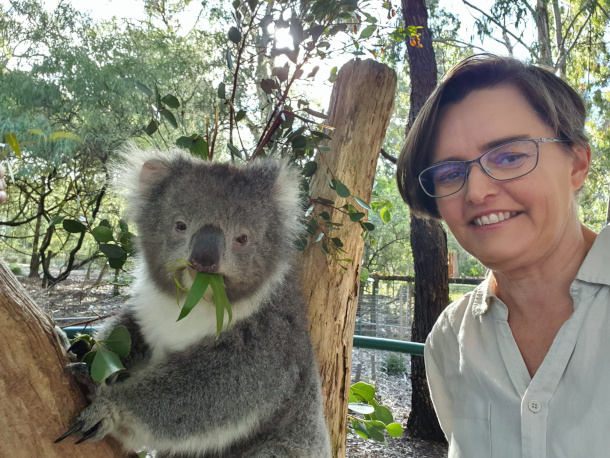
Author Danielle Clode (pictured) says that koalas’ features naturally tap into our parental instincts. (Photo: Danielle Clode)
DOERING: Wow.
CURWOOD: Now, what about the feeding of the young? I mean, how can the mother koala turn off the normal digestive system for the koalas to get the microbes that they're going to need ultimately to digest those leaves?
CLODE: The first thing is that koalas are marsupials, so they are very different from other eutherian or placental mammals like us. When they're born, they are tiny little pink Jelly Bean things. They're little more than a mouth and a pair of front legs that crawl up into the pouch. And then they have like a second external pregnancy almost. So the babies grow inside the pouch, and are attached to the nipples. The way in which the koalas transfer their babies from a milk diet onto a leaf diet is quite interesting and tricky, because at some point, the mother koala actually ejects a special soup for the baby, which is the contents of a part of the digestive system called the cecum. Which in humans, that's the appendix, but in koalas it's a much larger organ. Our appendix is only about the size of our thumb, and theirs is a meter and a half long. So she ejects that microbial soup and the baby koala eats that soup.
DOERING: Delicious!
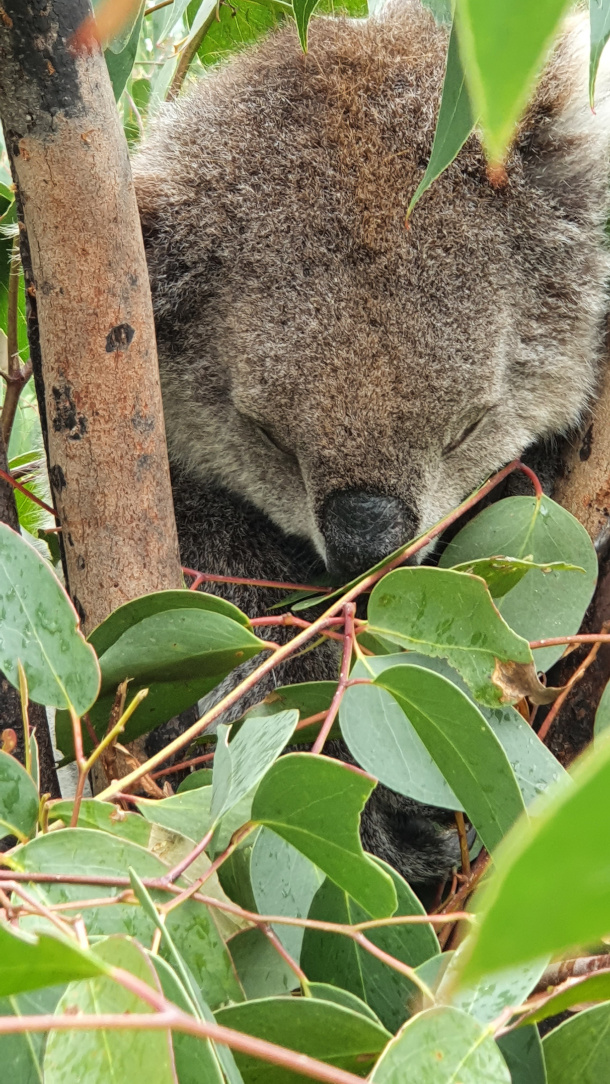
While koalas feed on about 70 species of eucalyptus trees, any one individual koala typically prefers between three and ten species. (Photo: Danielle Clode)
CLODE: Which is a pretty messy, disgusting looking thing, it has to be said. There's no other way for it to be described. It's quite horrifying really. But the baby koalas just love it. They can't get enough of it. And that gives them the microbes they need to digest the eucalypts. Not only to digest eucalyptus generally, but quite probably to digest the specific eucalypts that are in the forest they're in, because there's about 70 species of eucalypt that are known to be eaten by koalas, and any one individual koala will only eat between 3 and 10 different species. So they're quite specialized on particular trees. But not only that, they're also specific about which individual trees they'll eat. And it seems to change by season and by day, and that's what makes them so difficult to keep in zoos. They are one of the most expensive animals to keep in zoos, especially overseas, because you can't feed them pellets or a bit of bale of hay like you can other herbivores. They have to have fresh gum leaves, they have to have a lot of fresh gum leaves, and they have to have a really wide choice of gum leaves. Otherwise, you can end up with a koala that's eating, but it will just waste away and die because it's not getting the nutrients it needs.
DOERING: So, Danielle, there's kind of a stereotype that koalas are really cute, but maybe not the brightest animals. How would you respond to that?
CURWOOD: Wait a second! No allusions to the dumb blonde stuff that goes around in our society. You can be cute and smart, can't you?
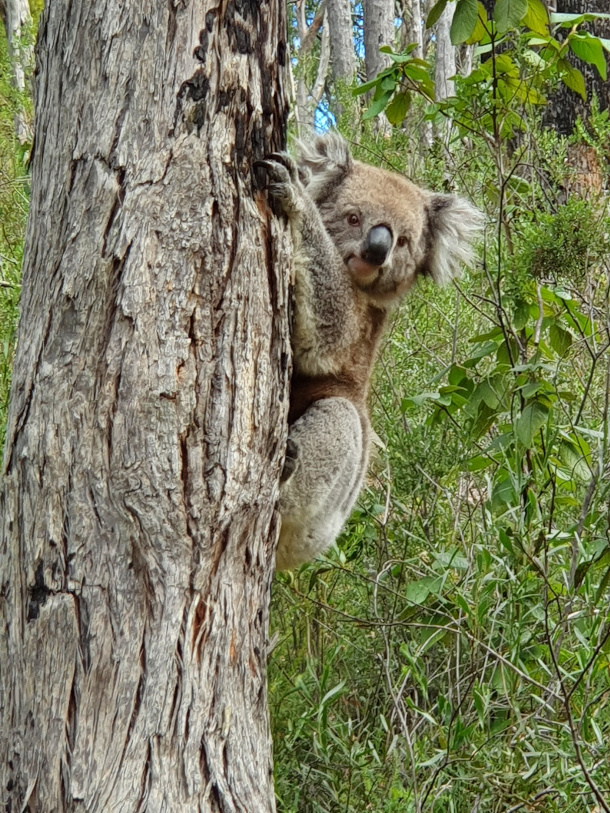
Koalas’ specialized diet makes them one of the most expensive animals to keep in zoos. (Photo: Danielle Clode)
CLODE: Absolutely. I think there's certainly a very strong narrative going around that koalas are not very bright, and in fact, there's a bit of a myth that marsupials are not very bright. And I think that this sort of, there's a lot of, you know, northern hemisphere Old World bias going on there. As European explorers extended out over the world, they typically were a bit derogatory about species. So marsupials were seen as primitive, maladapted, and stupid. And I think that's simply not true. They're extremely well adapted. And marsupials, if we look at their brain sizes, we find that they're pretty average. The ones that are off the scale are actually the primates. So we're a bit weird. Everything else is fairly standard. But I think the other thing that makes people think that they're a bit stupid is that they sleep a lot. So you know, and that leads to this myth that koalas also sleep a lot, because they eat toxic eucalypt leaves, and that has some sort of bad effect on their brain or their health or even makes them stoned. They're all myths. The koalas are definitely not stoned. They just like relaxing. And it's the same as your dog or your cat. If you give it plenty of food, your dog or your cat will spend a lot of time asleep, because it can. It's got a comfy bed, a nice house, lots of food, doesn't need to worry about predators. And that's exactly what the koalas are doing. They're up a tree, they're fairly safe, all day they've got food all around them. They can just sit back, relax and digest and have a snooze. I mean, it's a perfect life, I think.
DOERING: Sounds like it.
CURWOOD: But it's quite complicated, their environment, they have to find the right kind of eucalyptus tree--the way you write about them, they're far from dumb.
CLODE: Yeah, there's a lot of things going on that we maybe don't give them as much credit for: how they find the trees they want to feed on, is it random? Do they have some sort of cognitive map? We don't really know. But they're very good at finding their dispersed food supply. So to support one koala, you need a forest the size of an average sports field. And in arid areas, it's even bigger. It could be one koala per an area the size of Central Park.
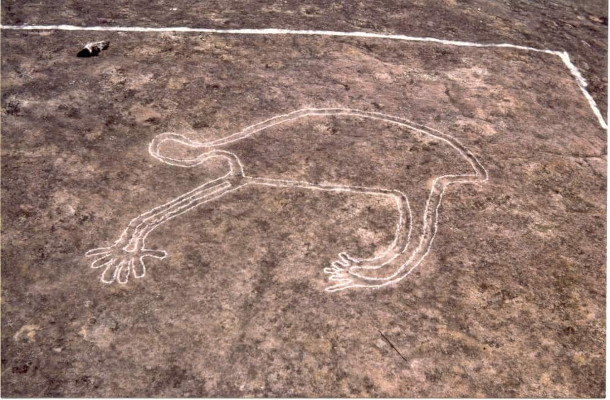
In many Australian aboriginal stories, koalas often rescue or advise humans. An aboriginal rock carving of a koala is pictured above. (Photo: Ralph Hawkins)
CURWOOD: Oh, my. That's almost that's like two square miles.
CLODE: Yeah.
CURWOOD: Speaking of awareness, there's this great scene in your book about a canoe and a koala. Can you can you tell us that story?
CLODE: Yeah, it was a really interesting, you know, some students were up on the River Murray and they noticed a koala stuck in a tree. So they swung the canoe around so that it was touching the tree and the koala watched what they were doing, climbed down into the canoe, and then just sat very comfortably until they swung the canoe around so that it was touching the bank, and then it hopped out and went on its way. And it was just a really interesting little piece of behavior that it was quite clear the koala was watching what the humans were doing. So it had some element of foresight about predicting what these other animals would do in relation to it. But I guess we just don't often think about koalas in those terms.
DOERING: Right. So Danielle, how did koalas figure into the culture of the hundreds of different indigenous peoples of Australia, traditionally, and today?
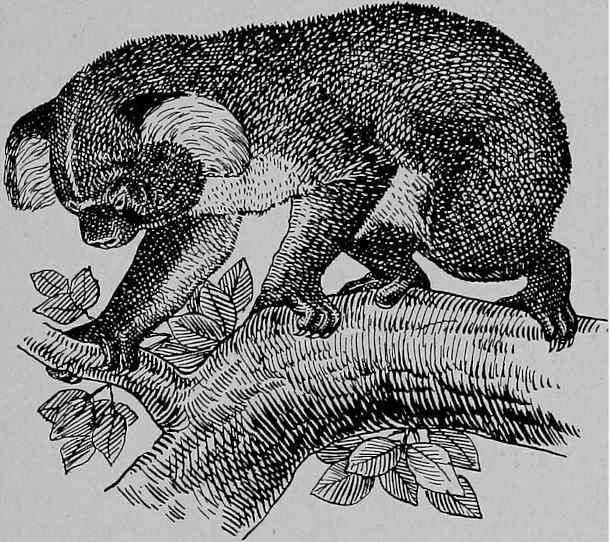
European explorers exploited koalas for their fur, hunting them to near extinction in the early twentieth century. (Photo: Internet Archive Book Images, Flickr, public domain)
CLODE: Yeah, koalas are a really important species in the dreaming stories of indigenous Australians, so the stories of the ancestral beings that created, you know, the country. And it's really interesting actually, a lot of the stories reflect past climate change events, so at a time when the sea levels rose dramatically. And koalas often feature as an animal that came and rescued humans and helped them get to safety on the land when the sea levels rose. So these stories are really interesting because they actually reflect very ancient geological events. And they tell us that these stories have been preserved for a very long time for, you know, seven or eight thousand years, which is a remarkable length of time to preserve a story. But they have a lot of other meanings as well. And it's difficult for a non-indigenous person to discuss them because the levels of meaning are different depending on the level of knowledge you have in that community. So most of the stories are teaching us about balance in nature, and how to restore balance by listening to the country and listening to the animals. And there's a really lovely story when people are walking through the forest and they're wondering, you know, deciding which path to take, they see a koala. They'll stop and they'll get the advice of the koala. But I really like that idea of slowing down and taking a bit of "koala" time, and taking your time to make decisions and think about where you are and what your place is in the environment.
CURWOOD: Wow. So listen to the koalas, or watch the koalas. And then came a time when Europeans came to Australia. What did the European colonizers think of these fuzzy creatures when they encountered them?
CLODE: Well, surprisingly, they didn't notice them to start with. It took them a while before koalas really came to European attention. And I think it really wasn't until they came to commercial attention that interest really geared up and that was in the late 1800s and early 1900s when the fur trade really was firing up and koala hunting was a huge thing. So we had a huge number of pelts of Australian animals, including koalas, being shipped to the US and UK fur markets. And that really started galvanizing concern in the local community about koalas going extinct.
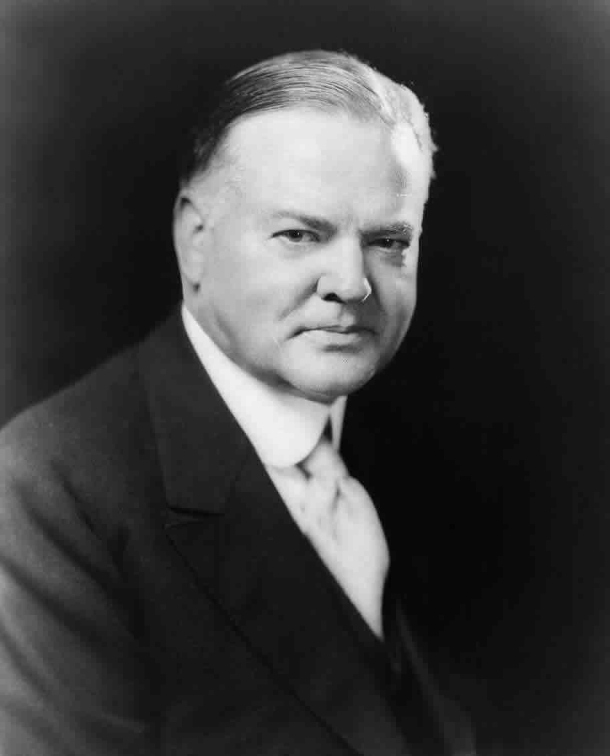
Herbert Hoover, America’s 31st President, banned the importation of koala and wombat fur in 1930, after Australian conservation advocates implored him to take action to save the species. (Photo: Opus Penguin, Flickr, CC BY-SA 2.0)
DOERING: Yeah, you write in your book about that koala fur was maybe even being used, along with some other marsupial fur, in children’s toys, you know, making a stuffed koala, like a teddy bear. And this was around the time when teddy bears were becoming popular as well. And they were using koala fur in some cases.
CLODE: Yeah, the idea of having a toy koala made out of actual koala fur is pretty horrifying. But I think that it's interesting, the children's toys then became part of a conservation movement, which was really prompted by you know, this is a really good example. It's a classic Australian book: Blinky Bill by Dorothy Wall. And this is really a book that really teaches kids about koalas and really sends a really good conservation message. You know, it's about koalas being displaced out of their habitat. It's about the interactions with humans, the threats they face, and how they survive. I mean, it's also a really fun story about a naughty little koala. But those children's writers who wrote about koalas were one of the really big galvanizing public campaigns to protect koalas. Really, it was actually really interesting that although there was a lot of public campaigns to stop koala hunting, it continued right up until 1930. And the thing that stopped it was that the conservationists made an appeal to Herbert Hoover, the American President, because he had lived in Australia and had a particular fondness for Australia. And they appealed to him to do something about the koala hunting and he banned the importation of fur from Australia. And that dried up the trade and stopped the hunting. So American conservation efforts have really played a very important role in koala conservation.
CURWOOD: So let's talk about the habitat situation for koalas. If anyone was paying attention to the news a summer ago, the horrific fires and pictures of koalas sort of treed by flame, and horrible body counts. What's the risk of extinction from habitat loss for these animals?
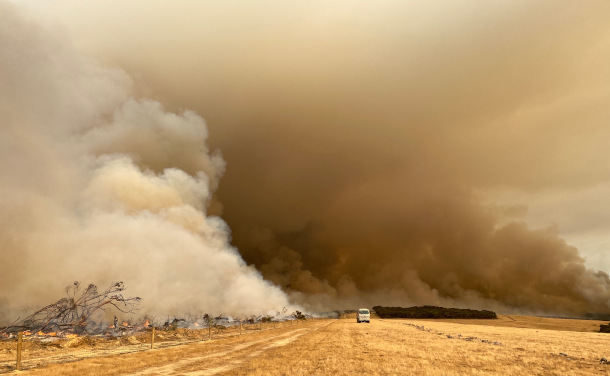
The 2019-2020 Australian bushfire season, known as Black Summer due to its historic intensity, killed or injured thousands of koalas. (Photo: robdownunder, Flickr, CC BY-NC-ND 2.0)
CLODE: Obviously, Australia, like a lot of places, has lost a lot of forest cover. So you know, we have cut down a lot of our forests. So that definitely plays a big role in the problems koalas face. So koala populations are declining quite precipitously, and quite worryingly, along the east coast, and that's why they've been declared endangered in those areas. In other areas, though, they are actually increasing. So in Victoria, in the south, where they almost went extinct through hunting, they have come back through a translocation program. That's a very strong population. And the same thing has happened in South Australia. And those populations are booming. But I guess that what that tells us in both cases, is that some of the problems we have with fragmentation of habitat. So you know, on the east coast koalas are trapped in forested areas, they don't have areas to move out to, they can't disperse. They can't maintain their populations. They have disease problems, you know, through close proximity. As we know, when we're stuck in a small area disease transmission is a problem. And in the south, where we have a lot of koalas, they're still in fragmented habitat. So even though they're doing really well, they have nowhere to go. And we have overpopulation problems. So we actually have koalas killing the forest. So you have sort of opposite problems, but they're caused probably by similar things. And that's the fragmentation of habitat and the loss of habitat. So we need to find ways of making sure that when we are doing developments, we make sure they're wildlife friendly. We put corridors in, we protect, you know, that we make sure the roads don't fragment the habitat, that the animals can move across them. And in terms of climate change, bushfires are increasing, which causes an additional problem because the forests are highly flammable in Australia. And if we've only got small areas of forest left, and those patches burn, there's no other food for the koalas to access. And that's when extinction really happens in local areas.
DOERING: Well, Danielle, what can be done to protect koalas now? What do you see on the horizon for them at this point?
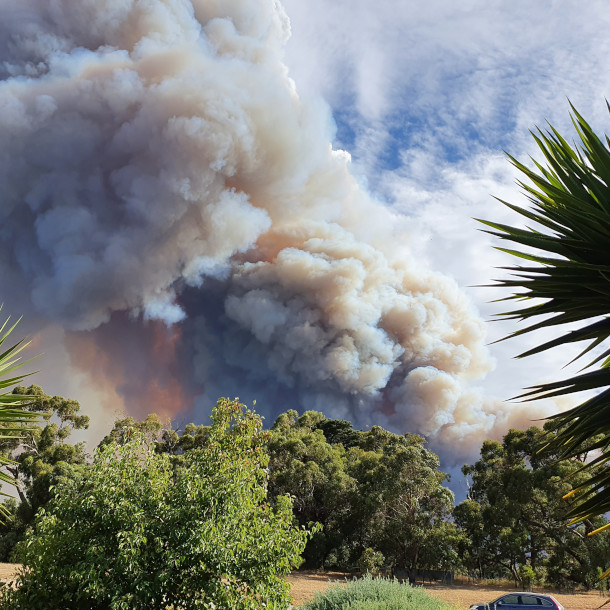
A bushfire rages near the author’s home, where koalas are abundant. (Photo: Danielle Clode)
CLODE: I think one of the main things I got out of doing this research and looking at them across the whole country and back into their pre history, and the evolutionary history as well, is just how resilient and robust koalas are. They have come back from multiple near extinction events, not just the hunting, but also the Ice Age extinction event that wiped out a lot of the megafauna around the world. So they're a really really resilient species. And if koalas are struggling the way they are on the east coast, I suggest that means we're doing something really dramatically wrong. I think it suggests that we do need to completely shift our focus in how we run our economies and manage our development and how we live with the world. And we do need to find a more compatible, more sustainable way of living with a stronger environmental foundation, which is better for us and also better for koalas and all the other species.
CURWOOD: I just want to say thank you for taking the time with us today. It's a marvelous, fascinating book.
DOERING: Thank you so much, Danielle. It's been a real pleasure to speak with you.
CLODE: Thank you for having me. It's been marvelous.
DOERING: Danielle Clode’s new book is called Koala: A Natural History and An Uncertain Future.
Related links:
- Watch the full interview with author Danielle Clode of "Koala"
- Find the book "Koala: A Natural History and an Uncertain Future” here (Affiliate link donates a portion of the proceeds to LOE and independent bookstores)
- Danielle Clode’s website
- Australian Wildlife Conservancy
- Koala Life
[MUSIC: Bill Tapia, “Lady Be Good” on Duke of Uke, by George and Ira Gershwin, MOOnBoomRECORDS]
The Next Event in the Living on Earth Book Club
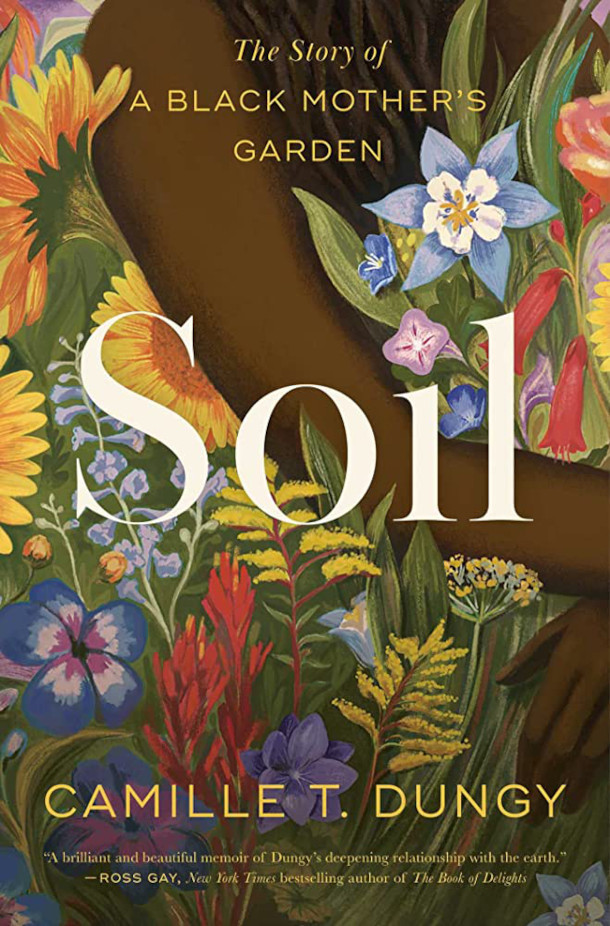
CURWOOD: Our next Living on Earth Book Club event on April 26th at 7 p.m. Eastern features “Soil: The Story of a Black Mother’s Garden” by Camille Dungy. And it’s free! Just sign up at loe dot org slash events.
Related links:
- CLICK HERE to register for this upcoming live event
- Purchase a copy of ‘Soil: The Story of a Black Mother's Garden’ (Affiliate link helps donate to LOE and local indie bookstores)
[MUSIC: Bill Tapia, “Lady Be Good” on Duke of Uke, by George and Ira Gershwin, MOOnBoomRECORDS]
DOERING: Coming up – A civil and religious rights lawsuit seeks justice for Black communities along “Cancer Alley” in Louisiana. Stay tuned to Living on Earth.
ANNOUNCER: Support for Living on Earth comes from Friends of Smeagull the Seagull and Smeagull’s Guide to Wildlife. It’s all about the wildlife right next door to you! That’s Smeagull, S - M - E - A - G - U - L - L, SmeagullGuide.org.
[CUTAWAY MUSIC: Djeli Moussa Diawara & Bob Brozman, “Almany” on Reves D’Oasis: Desert Blues 2, by Djeli Moussa Diawara/Bob Brozman, Network Records]
Beyond the Headlines
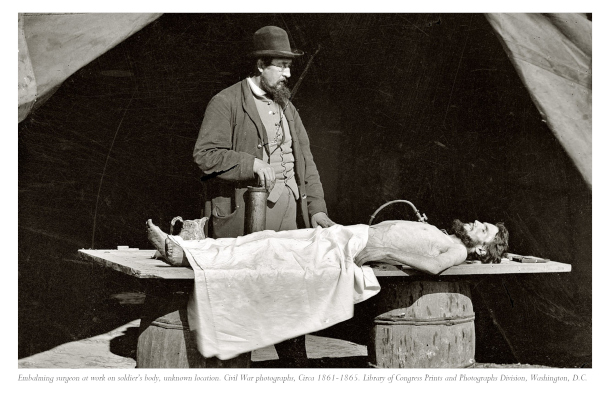
Embalming became common practice during the Civil War to preserve soldiers’ bodies so they could be buried at home. (Photo: Wagner Free Institute of Science, Flickr, CC BY-NC-ND 2.0)
CURWOOD: It’s Living on Earth, I’m Steve Curwood
DOERING: And I’m Jenni Doering
It's that time now for a look beyond the headlines with Peter Dykstra our living on Earth contributor. Peter joins us from Atlanta, Georgia. Hey, Peter, what you got this week?
DYKSTRA: Hi, Jenni, we'll start out with a little unconventional news. It's something that's been around for a while, but apparently on the increase, and those are green burials.
DOERING: And by the way, what is a green burial?
DYKSTRA: Well, it involves putting the body in a wrap inside, some cases of bamboo casket rather than a metal one, and in every way, making it less toxic, and I think more practical. Up until the American Civil War, green burials were the standard because there weren't embalming chemicals and a lot of money for expensive funerals. And also people tended to die close to home. But when the Civil War came around, men were dying in battlefields, hundreds of miles from home, and they needed to be preserved in order to be sent back home for proper burial.
DOERING: And one can see why embalming bodies during the Civil War would be so important, but that involves a lot of chemicals. Right, Peter?
DYKSTRA: A lot of chemicals, a lot of other hardware. There are some stats from the Green Burial Council. They say that 4.3 million gallons of embalming fluid go into the ground each year in graveyards, and 10 times the amount of carbon is emitted from a traditional burial than is admitted in a green burial.
DOERING: Well, and what about cremation, Peter? I mean, you know, burning our bodies that leaves behind just a little bit of ash.
DYKSTRA: Well, that involves up to a couple of hours of time in the furnace at nearly 2000 degrees equal to driving a car 500 miles.
DOERING: Well, Peter, what else do you have for us this week?
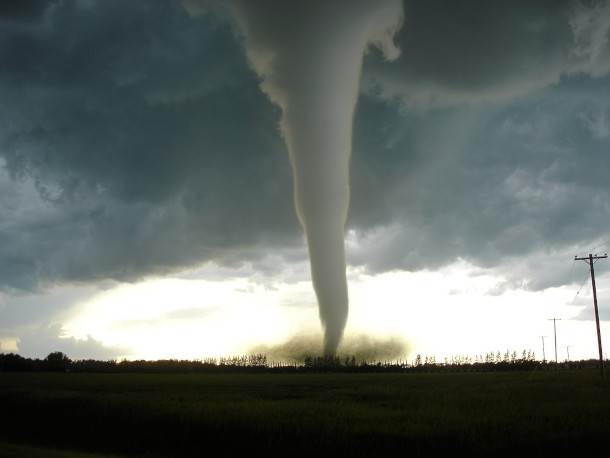
A new study indicates that there may be a connection between climate change and the weather systems that sometimes precede the emergence of extreme tornados. (Photo: Justin Hobson, Wikimedia Commons, CC BY-SA 3.0)
DYKSTRA: Well, this is a pretty important study. Let's hope we didn't bury the lead. But from the University of Northern Illinois, and the United States Air Force science office. A recent study says that there may be a link between climate change and extreme tornadoes. We've long since known a lot of the impacts of climate change. Tornadoes have never been proven to have climate change and warming weather as a cause.
DOERING: Wow. So what are the links that they're seeing between climate change and tornadoes?
DYKSTRA: It's actually the precursors to a lot of major storms, the supercells, that can cause tornadoes, like the ones we saw recently, from the Gulf Coast in the south, up to the Midwest. Those tornadoes may have that link to climate change because extreme tornadoes, according to the study, might be moving farther east. Tornadoes overall, may not necessarily be as frequent, but the ones we get will be more destructive and more intense.
DOERING: Wow, so we might even need to redefine what we call Tornado Alley?
DYKSTRA: Tornado Alley is still going to get a lot of tornadoes. But overall, if we're worried about the most destructive tornadoes, this one lonely study may help prove one more major source of damage from climate change.
DOERING: Hopefully as time goes by, we'll have more studies coming out and shedding some more light on this tricky atmospheric phenomenon. Well, Peter, what do you have for us in the history calendar?
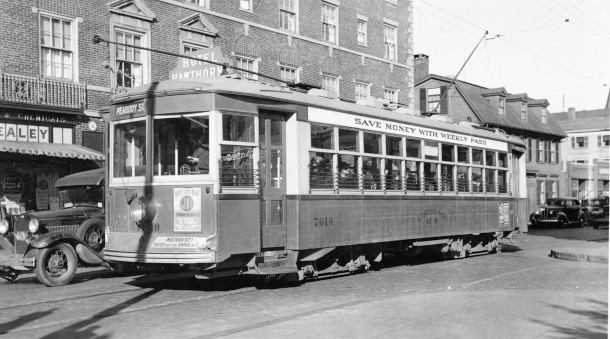
On April 9th, 1947, nine car, tire, and gas companies are convicted under anti-trust laws for conspiring to shut down streetcar lines around the country. Debate continues as to whether there really was a conspiracy. (Photo: Salem State Archives, Wikimedia Commons, CC BY 2.0)
DYKSTRA: A 75th anniversary of something that's still debated today: April 9 1947, the federal government indicted nine corporations for violating antitrust laws. Those corporations led by GM but also including Firestone Tires, Mack Trucks, Standard Oil of California, and several others were accused of conspiring to shut down streetcar lines in Los Angeles and other cities in order to replace them with buses. The trial took two years and a jury ultimately convicted them and posed token fines. The case is debated to this very day on whether or not it really was a conspiracy, or just a random conspiracy theory that the internet is so fond of.
DOERING: Well, thank you, Peter. Peter Dykstra is a living on Earth contributor, and I will talk to you again next week.
DYKSTRA: All right, Jenni, we'll talk to you soon.
DOERING: And there's more on these stories on the living on Earth website. That's loe.org.
Related links:
- Learn about eco-friendly death options and legislation that expands green death options
- Create a tornado emergency plan and donate to victims of the recent disasters
- Read a full history of the streetcar
[MUSIC: Nashville Mandolin Ensemble, “Cuban Landscape With Rain” on Plectrasonics, by Leo Brower arr/Nashville Mandolin Ensemble, CMH Records]
Righting the Wrongs of Environmental Racism
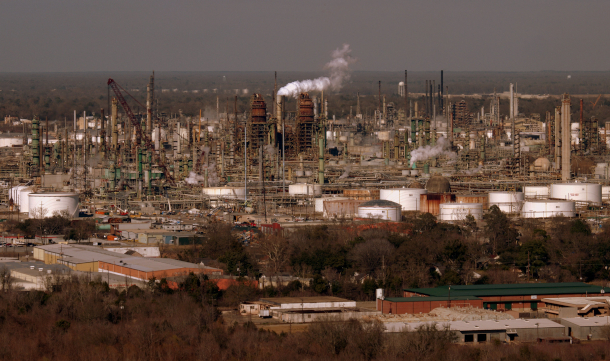
ExxonMobil’s Baton Rouge Refinery along Louisiana’s “Cancer Alley.” (Photo: Jim Bowen, Flickr CC BY 2.0)
CURWOOD: The Black residents of the heavily industrialized corridor along the Mississippi in Louisiana known as “Cancer Alley” have been fighting for years to stop new petrochemical plants, but each battle has been a bit of a game of “whack-a-mole”. Now they’re bringing a civil rights and religious liberty case against a local government body that has given a green light to these polluting facilities for decades. The lawsuit alleges that the St. James Parish council has “intentionally chosen to locate over a dozen enormous industrial facilities in the majority Black fourth and fifth districts, while explicitly sparing white residents from the risk of environmental harm.” The suit seeks to enjoin the council from issuing any more industrial permits in black neighborhoods. Monique Harden is the Director of Law and Policy at the Deep South Center for Environmental Justice and joins me now from New Orleans. Welcome back to Living on Earth, Monique!
HARDEN: Hi, Steve, great to be back.
CURWOOD: Our pleasure. Now this case has a unique approach, at least to my eyes, because they're not selling on the basis of pollution exposure alone, but on the basis of systemic racism and discrimination going back since the first days of slavery on the sugarcane plantations there. What's the history of what happened there?
HARDEN: Well, this is a case that is novel but sorely needed in communities that have bared the burdens of legacy pollution that date back for generations. In St. James Parish, Black communities have borne the burdens and hazards of toxic pollution raining down on them from industrial facilities that were all approved without their say. This goes back to the 1940s in Jim Crow Louisiana, when Black residents in particular did not have the right to vote. And so issues around land use, zoning, how they would be represented, how decisions would be made around what would be developed in their environs was something that they were denied, brutally, in the South and here in Louisiana and in St. James Parish. So what this lawsuit sets out to do is really to remedy and correct that wrong that continues and persists to this very day.
CURWOOD: Now, in addition to being a civil rights and environmental justice lawsuit, this is also about religious liberty, according to the complaint from the plaintiffs. What's the basis for bringing the action on the grounds of religious freedom, and what are the laws there?
HARDEN: Well, the basis is that there's a law protecting the exercise of religious freedom and institutions. And what the facts show is that land use planning sets aside buffer zones to protect Catholic churches and places of worship from industrial development, but not the same for any other religious institution or place of worship in the parish.
CURWOOD: And of course, I gather the bulk of Black people there are not Catholic, they're Baptist, whereas probably the majority ethnicity of the Catholic churches there are white. How accurate is that perception?
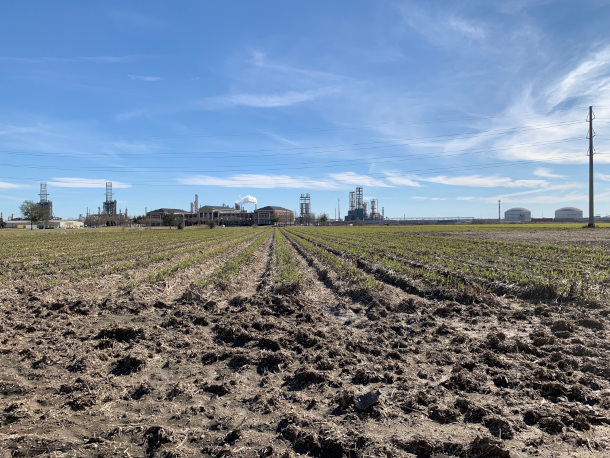
Sugarcane fields in front of the Marathon Garyville refinery in St. John the Baptist Parish, adjacent to St. James Parish, Louisiana. Enslaved African Americans once toiled to grow sugarcane on plantations, and today petrochemical plants are replacing agriculture in the region. (Photo: Jenni Doering)
HARDEN: You will find Black Catholics throughout Louisiana, but the numbers are larger among white residents. More likely than not, it does follow mostly along racial lines, so that it's more likely that white Catholics would live next to Black Protestants, mostly Baptists, throughout the state.
CURWOOD: What's the role of the cemeteries along the Mississippi there? The cemeteries that, it's understood that people who were enslaved working the sugarcane plantations back in the day, are either already under factories or in places that factories want to build.
HARDEN: Or in places where the factories have control over the sites in terms of access to them. That's also the case here in Cancer Alley. This has only happened, right, because of the total lack of regard for Black people, Black communities, and Black burial places. Cemeteries of deceased Black residents of St. James Parish are not afforded the same protections, as the case for cemeteries where there are, white residents of the parish have been buried. So righting those wrongs is what's front and center of this lawsuit. You know, you're talking about places where people who have gone on and passed on, are relatives of folks living today and fighting for the places that they call home. And if you can take away a community cemetery, and you can take away their right to clean air, clean water, clean land, what's left? What's left? And so you see residents really fighting for a way of life that has never been protected by their parish government and trying to right that wrong.
CURWOOD: Please give me an example of what the plaintiffs say is discriminatory behavior by the planning boards there in that county when it comes to industrial plants.
HARDEN: It's real simple. The planning boards do not afford the same protection to Black communities in the parish as they do to white communities in the parish. So in the lawsuit, the plaintiffs discuss the St. James Parish planning Council's decision in an application that was brought by an industrial company called Wolverine Terminals. This Corporation had sought a land use approval from the St. James Parish Council, where they wanted to build a terminal for crude oil storage in a predominantly white part of St. James Parish, where residents were more than eighty percent white and just about thirteen percent black. That application was denied by the St. James Council, on the grounds that the company did not consider locating in a Black community in the parish.
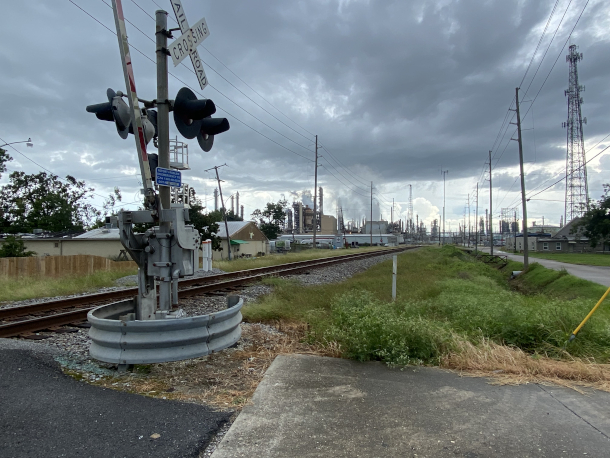
Petrochemical plants near residential neighborhoods in “Cancer Alley” along the lower Mississippi River in Louisiana. (Photo: Courtesy of Deep South Center for Environmental Justice)
CURWOOD: So just blatant like that, huh?
HARDEN: Yes. You know, stepping into St. James Parish and looking around and driving around the community, it's, the landscape just exhibits that racial divide in terms of where industrial, you know, heavy polluting industrial facilities are able to locate and operate, in Black communities, and you don't see them in the white communities. And it's not to say that white communities should have them too. You know, our position at Deep South Center for Environmental Justice that no community should have it. But what we see in St. James Parish, what this lawsuit points out is that the discrimination is one where it forces all of the hazards and all of the health and safety risks and the denial of a sustainable future for Black communities in the hands of a parish council that makes decisions like this.
CURWOOD: Monique, why have environmental laws, like the Clean Air Act and the Clean Water Act, failed to get results when it comes to environmental justice?
HARDEN: Well, it's because they do not address the tremendous health concerns that communities, Black communities in St. James Parish, for example, have. Instead, the laws operate in accordance with equipment, devices, modes of processing and operations, that is already in existence within an industrial sector. So that if you own a company in a particular industrial sector that's regulated under the Clean Air Act, the only thing you have to do is meet the standard of peers within your industrial sector that are now codified in the regulations under the Clean Air Act. So you see how a community's demand around health and safety are not addressed in that kind of a framework.
CURWOOD: Now, a number of years ago, you won a case blocking a big company called Shintech from setting up a plant there. If the environmental laws like the Clean Air Act and Clean Water Act don't really address this, how are you able to succeed in that case?
HARDEN: Well, the case against Shintech that I brought along with lawyers and law students at Tulane Environmental Law Clinic focused on bringing in something outside of the Clean Air Act for the EPA to consider. And that was the then President Executive Order on Environmental Justice that called on EPA and other federal agencies and departments to prevent racially disproportionate pollution burdens. So our argument was that our state agency had drafted an air permit for the Shintech company in St. James Parish, back in 1996, that not only didn't comport with the legal requirements under the Clean Air Act, but it also would fail to ensure that the environmental justice called for in the executive order would be followed. And so you know, that landed on the desk of EPA Administrator Cal Browner, who made the right decision in finding that environmental justice is a priority for the agency, also agreeing with us on the numerous errors in how the permit was drafted that did, in fact, even violate those bare basic minimum requirements for that facility. And also doing another thing that was really unprecedented at that time, which was setting the EPA on a course for civil rights enforcement as a way to carry out the obligations of the agency has under the executive order on environmental justice. And so what we did in the Shintech case, in some ways, is similar to what's happening here in this lawsuit, which is going outside, beyond, those environmental legal requirements, because they really don't address the health and wellness and sustainability of a community, but instead looking for other support in law and policy.
CURWOOD: Monique, to what extent does the history of not just slavery, but later on Jim Crow, and the inability for many, I think almost all Black people couldn't vote until the Voting Rights Acts come along in the 60s. To what extent does the lack of the vote by people of color undergird this massive discrimination when it comes to putting polluting sites along the Mississippi?
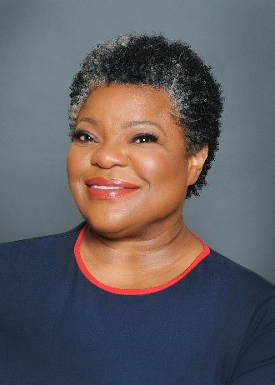
Monique Harden is the Director of Law and Policy and Community Engagement Program Manager at the Deep South Center for Environmental Justice. (Photo: Courtesy of Deep South Center for Environmental Justice)
HARDEN: It's really central, Steve, because it was this denial of the right to vote and participation in decision making that affects your life, denied to Black residents across the South under Jim Crow system, that opened the door for oil refineries, gas production, chemical manufacturing, and now plastic production to come into so many places in the southern region where Black communities, Black people were able to settle and found and develop communities, places where hundreds of families could call home. And those places became targets for this kind of industrial development at a time when, of course, the residents didn't have a voice in even leveling a protest against it, let alone asking questions regarding it.
CURWOOD: So you've been involved in this kind of litigation and efforts to address environmental injustice for a number of years. What do you see the odds of this particular lawsuit moving forward, at least getting into the discovery phase where information will have to be revealed by this set of parish officials and planning councils?
HARDEN: I think the plaintiffs and their lawyers have really done a really good job of laying out how this particular parish government's decisions violate the rights of Black residents in the parish, and looking at the laws that protect those rights under the federal non discrimination laws, federal protections for the exercise of religious freedoms. And so in that way, it really brings together much of what the environmental justice movement is set on, which is protecting the rights of people to enjoy the places that they call home. And you can't enjoy the place you call home if your parish government is targeting you and bombarding you with one toxic facility after another.
CURWOOD: Monique Harden is the Director of Law and Policy and the Community Engagement Program Manager at the Deep South Center for Environmental Justice. Thank you so much for taking the time with us today.
HARDEN: Thank you for having me.
Related links:
- Read the complaint against the St. James Parish Council
- About the EPA’s 1997 Shintech decision citing environmental justice and civil rights
- About Monique Harden, Esq.
- Listen to Living on Earth’s story about enslaved people buried in Louisiana’s “Cancer Alley”
[MUSIC: Cyrus Chestnut, “Over My Head” on Blessed Quietness: A Collection of Hymns, Spirituals, and Carols, anonymous 19th century African-American spiritual, Atlantic Records]
CURWOOD: Living on Earth is produced by the World Media Foundation.
Our crew includes Fern Alling, Naomi Arenberg, Bobby Bascomb, Paloma Beltran, Iris Chen, Josh Croom, Swayam Gagneja, Mark Kausch, Mark Seth Lender, Don Lyman, Jusneel Mahal, Louis Mallison, Aynsley O’Neill, Sophia Pandelidis, Jake Rego, El Wilson, and Jolanda Omari.
DOERING: Tom Tiger engineered our show. Alison Lirish Dean composed our themes. You can hear us anytime at L-O-E dot org, Apple Podcasts and Google Podcasts, and like us, please, on our Facebook page - Living on Earth. We tweet from @livingonearth. And find us on Instagram at livingonearthradio. And you can write to us at comments at loe dot org. I’m Jenni Doering.
CURWOOD: And I’m Steve Curwood. Thanks for listening!
ANNOUNCER: Funding for Living on Earth comes from you, our listeners, and from the University of Massachusetts, Boston, in association with its School for the Environment, developing the next generation of environmental leaders. And from the Grantham Foundation for the protection of the environment, supporting strategic communications and collaboration in solving the world’s most pressing environmental problems.
ANNOUNCER 2: PRX.
Living on Earth wants to hear from you!
Living on Earth
62 Calef Highway, Suite 212
Lee, NH 03861
Telephone: 617-287-4121
E-mail: comments@loe.org
Newsletter [Click here]
Donate to Living on Earth!
Living on Earth is an independent media program and relies entirely on contributions from listeners and institutions supporting public service. Please donate now to preserve an independent environmental voice.
NewsletterLiving on Earth offers a weekly delivery of the show's rundown to your mailbox. Sign up for our newsletter today!
 Sailors For The Sea: Be the change you want to sea.
Sailors For The Sea: Be the change you want to sea.
 The Grantham Foundation for the Protection of the Environment: Committed to protecting and improving the health of the global environment.
The Grantham Foundation for the Protection of the Environment: Committed to protecting and improving the health of the global environment.
 Contribute to Living on Earth and receive, as our gift to you, an archival print of one of Mark Seth Lender's extraordinary wildlife photographs. Follow the link to see Mark's current collection of photographs.
Contribute to Living on Earth and receive, as our gift to you, an archival print of one of Mark Seth Lender's extraordinary wildlife photographs. Follow the link to see Mark's current collection of photographs.
 Buy a signed copy of Mark Seth Lender's book Smeagull the Seagull & support Living on Earth
Buy a signed copy of Mark Seth Lender's book Smeagull the Seagull & support Living on Earth

